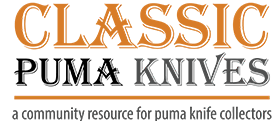When evaluating the condition of a knife, it is good to look at the standards adopted by the National Knife Collectors Association (NKCA).
The following assumes mint is 100%.
- New Manufactures Suggested List Price, or less
- Pristine Mint 100% plus
- Mint 100%
- Near Mint 80-90%
- Excellent 50-70%
- Very Good 40-50%
- Good 25%
- Poor 5-10%
- Junk under $10.00
As an example a near mint knife is worth 10% to 20% less than a mint knife. A excellent knife is worth 30% to 50% less than a mint knife. A knife in very good condition is worth 50% to 60% less than a mint knife. A good knife is worth 75% less than a mint knife. A poor knife is worth 90% to 95% less than a mint knife.
For years the standard for knife collectors has been the National Knife Collectors Association grading, established in 1973. Basically it is a sound grading standard, but as collecting has advanced many dealers adapted additional descriptions, and the overall collecting field has changed, to the point that many dealers feel there should be a more detailed grading system. The basic grading standards have been left intact, but what follows is a clarification and enhancement of those standards, and also the reasons for the revisions.
Cracks. One important exception: Cracks will occur in mint knives. If it is mint for everything except a crack, the knife is still mint-it is only mint with a crack. This should downgrade the value approximately 10% on most knives.
New: Never sold to a customer and never used. New as shipped by the manufacturer or distributor with all original packing (box, sheath, etc.) and instructions. Knives or any merchandise sold as “New” must be eligible for full warranty service from the officially authorized importer, distributor, or factory in the USA. New is what most knife stores sell and they are generally current production knives.
Pristine Mint: The coin world would call this MS-65-70, the ultimate in quality and condition and not just mint, but mint plus something, good fit, no specks on a very old knife, etc. Suffice to say there are very, very few of these out there. Perfect plus.
Mint: The standard mint, not sharpened, never used, and never carried extensively.
Revision: Almost any knife made prior to World War II is going to have some rust specks here and there. If you only wait for mint knives with no rust specks, for instance, you are going to get very few. Some knives that were mint in 1970 have now been in storage for over 30 years and they are starting to show some neglect spots here and there as well. I look for this to get worse in the future, since few collectors pay the attention they should to the maintenance of knives in their possession.
Near Mint: Nothing wrong with the knife, sharpened but no blade wear, some original polish still visible, carry scratches on the outside, no deep rust pits, full blades. (A mint knife that has rusted and been cleaned back to near perfect shape is near mint.)
Excellent: 5-10% blade wear, blades snap, some tarnish, and light pitting possible. A good solid lightly used knife. On a multi-blade knife, some of the smaller blades may still be near mint. Tang mark clear. Master blade not over 10% short.
Very Good: More blade wear than excellent, 15-25% wear, some blades may be slow, stamping readable but faint, some distinct cracks but no chips out of handle that have not been repaired. Blades still sound but may be slow. Some rust pitting and tarnish. Master blade may be short.
Good: NKCA standards refer to this as Fair, which I always confused with poor. Simply Good is worse than Very Good. 25%-50% blade wear, maybe a chip missing, replaced handles or blade is evident, but still able to identify maker, still useable as a working knife. Blades may be very slow. Deep pits and rust. Still has all the blades, even though worn and short.
Poor: Blades over 50% gone, usually short, handle may be chipped, one blade broken, blades lazy, tang mark just barely readable. Still useable for parts
Junk: (Not priced and no one I know collects them, but you do see them traded for $1.00-$10.00 each. Blades broken, one handle missing, all that is useable is bolsters, liners, and back spring. Maybe an old name or style.
